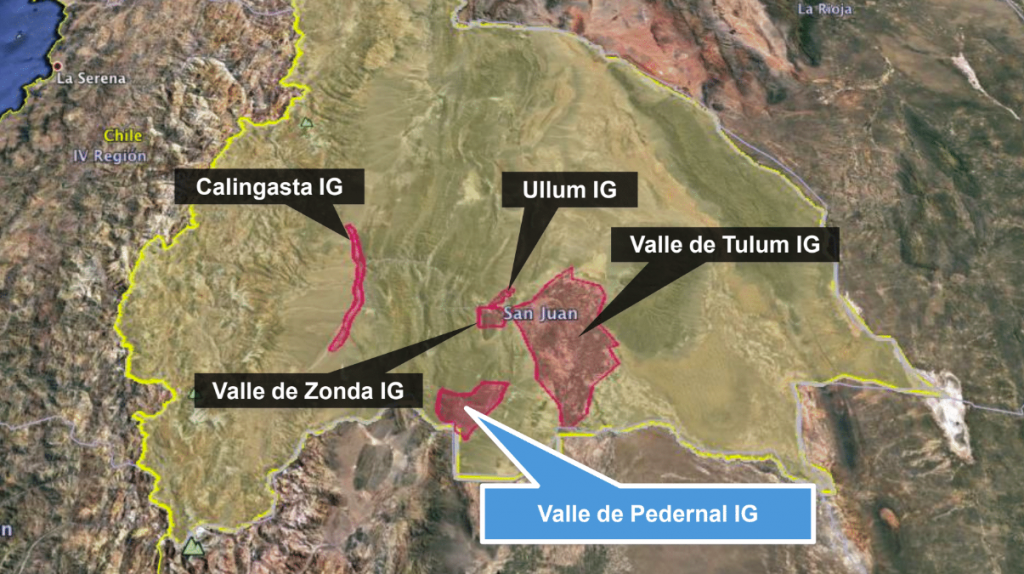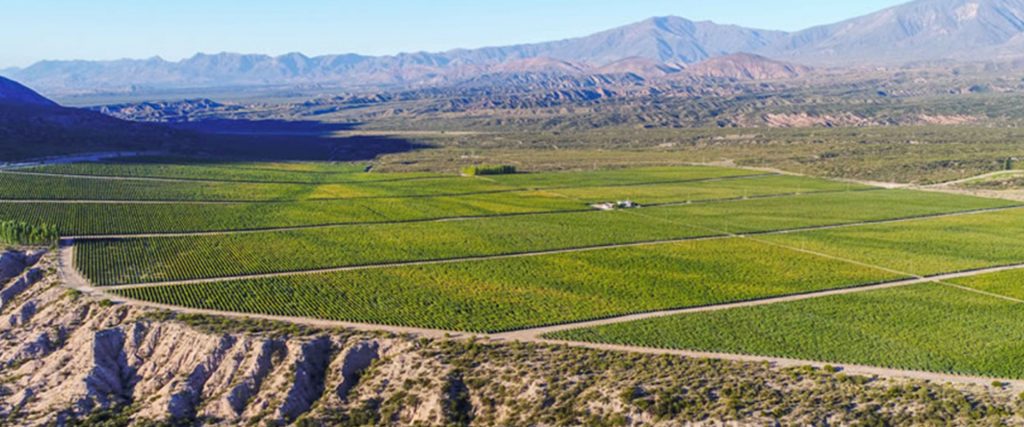When does a terroir become established in the minds of consumers? When it completes a cycle in which the wines it produces have set tongues wagging and its distinctiveness comes out clearly in the glass. That is exactly what is happening right now in the Pedernal Valley, located in the Andean foothills of San Juan Province, a region increasingly treasured by producers and purple-tongued consumers alike.
Boxed in by two very different mountain ranges – the Sierra del Tontal to the east and Sierra Pedernal to the west – it is precisely what comes to mind when one thinks of a valley: a deep, v-shaped gap with mountains on either side. And it’s these two geographic barriers that make the terroir so distinctive.
Topography is a key factor: the valley is on average about 1400 metres above sea level (masl), making it a cool oasis in the province, in contrast to the vineyards further down in the plains, which are about 600 masl. What kind of a difference does the altitude make? About 8 degrees Celsius. Even during the height of ripening season, the temperature doesn’t usually get higher than 28 degrees in spite of the high levels of direct sunlight, while the nights are much cooler.
Marcelo Belmonte, the Director of Viticulture at Peñaflor notes: ‘‘The Pedernal Valley is located in the foothills of the Andes and has a moderately cool climate with around 1600 growing degree days per season in which the temperature changes markedly between day and night; by about 15 degrees Celsius during most of the growth cycle and 10 degrees in the month prior to the harvest, with plenty of ultraviolet radiation throughout. The cool climate slows the ripening and temperatures plunge in autumn allowing the grapes to preserve their acidity and essential aromas, which tend to be volatile, and this leads to aromatic complexity and elegance in the wines´.
´The vineyards -he adds-, located on the slopes of the Pedernal Sierra face west meaning they get more sun in the evenings, while the other side is more exposed in the mornings, leading to variations in ripening among the different varieties. The soils also vary, with different kinds of stone and levels of calcium and lime, explaining the structure and texture of the tannins along with the excellent core in the mouth.’

There’s another topographical component too: the two slopes. One dips from the Tontal Sierra to the east while the other descends from the Pedernal range to the west, and each offers different degrees of exposure and quite distinct soils. The former contains the famous pedernals, flints used to start fires in ancient times that gave their name to the valley. The latter contains calcium-rich soils studded with meteorites according to research by the terroir experts Lidia and Claude Bourguignon. ‘As far as we know, it’s the only winemaking region of its kind in Argentina,’ says Gustavo Matoq, an Agricultural Engineer at Pyros Vineyard.
The major issue in the Pedernal Valley is the lack of water, which needs to be pumped up from very deep under ground, although frosts are also problem, especially in the deeper areas of the valley.
All together, these conditions result in the unique identity that one tastes in the glass. And enough is being produced to make it a factor on the market: about 800 hectares of vineyards are under vine in the Pedernal valley, which was first planted in the 90s with most vineyards only appearing this century. Potential capacity is 10 million bottles.
The new vines
But none of this would be anything but potential if it weren’t for the efforts of San Juan producers, along with some from Mendoza, to isolate the style of the region and bring out its flavours as much as possible. Even in a year as strange as 2020, several reds have appeared that will be remembered as landmarks in the region’s overall development.
Made with Malbec grown in limestone soils and 20% aged in new oak, Pyros Limestone Hill 2016 is paving the way for the new breed of wines from the region.
There had already been indicators – at Pyros as well as with wines such as Fuego Blanco Flintsone Malbec 2017, Paz Cabernet Sauvignon-Cabernet Franc 2018, Vasparo Malbec 2018, La Linterna Finca “La Yesca” Parcela 13 Malbec 2014 and BenMarco Extremo Malbec 2018 – that the region might offer a new and different style, but now the bar has been raised and the trend has become consolidated.
But there are also variations within the Pedernal valley itself: Malbecs from the soils on the Sierra del Tontal side offer a fruity, herbal profile with palates that deliver good body and intensity, while those grown on the Pedernal slope produce wines of equal intensity but more austere aromas with palates formed around a core of chalk, so long as the grapes aren’t overripe when harvested.
The Pedernal valley also produces Syrahs from cooler areas very different from those from the rest of San Juan, Pyros’ is a good example, alongside unusual whites such as Gewüztraminer and taut, voluminous high altitude Sauvignon Blancs.
Clara Roby, the Oenologist at Fuego Blanco, says: ‘At 1550 masl, where we are, ripening occurs very slowly, so white varieties, especially the Sauvignon Blanc, preserve their high acidity and present herbal profiles with hints of rue and thyme.
None of this is really new: the Pedernal Valley has been producing quality grapes for some time, the difference now is that it’s finally being appreciated as a terroir in its own right and promises to establish itself on the world stage.



